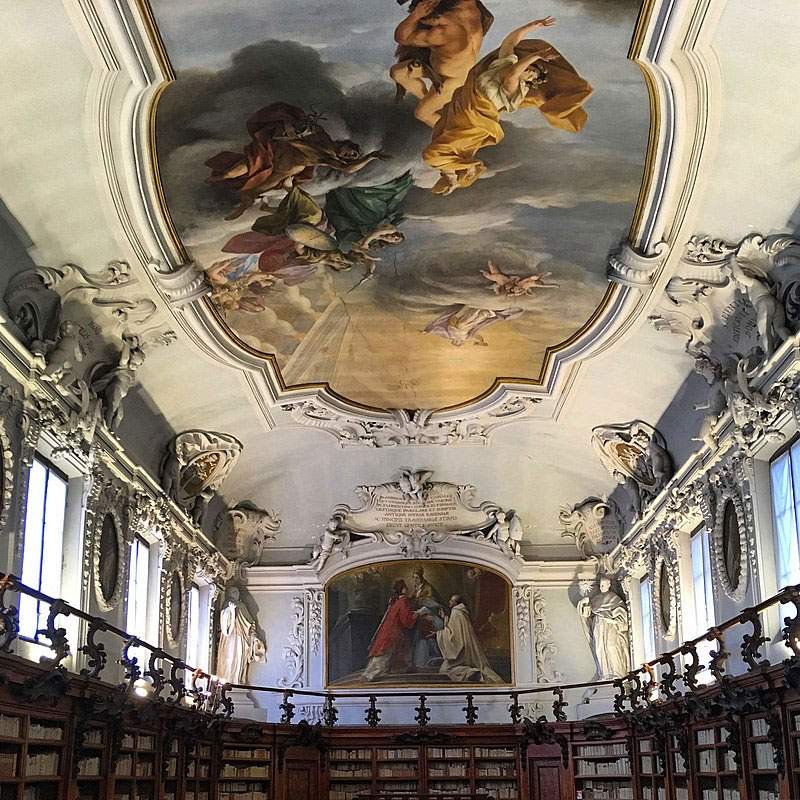From August 21 to November 6, 2021 Ravenna offers the widespread exhibition In su’lito di Chiassi. Dante’s Treasures in the Libraries and Archives of Ravenna, sponsored by the Ministry of Culture and the National Committee for the Celebration of the Seven Hundredth Anniversary of Dante’s Death, which is part of the Region’s project Dante and the Divine Comedy in Emilia-Romagna. The widespread exhibition aims to enhance the Dante heritage of fourteen libraries and historical archives in the region.
The project, organized by the Cultural Heritage Service of the Emilia-Romagna Region in collaboration with the Italian Dante Society, was conceived by Alberto Casadei and curated by Gabriella Albanese, Sandro Bertelli and Paolo Pontari. The Ravenna project includes two exhibitions, one in the Classense Library and the other at the Centro Dantesco dei Frati Minori Conventuali.
The path proposed by the Classense Library intends to offer, on the one hand, the opportunity to approach medieval documentary evidence related to Dante’s Ravenna years and, on the other, to retrace the stages of the reception of the Comedy, from the second half of the 14th to the end of the 15th century, through the manuscript and printed evidence belonging to the library’s rich Dante heritage and also thanks to the “F. Trisi” of Lugo, which lends the first rare edition of De Monarchia.
The collaboration of the State Archives, the diocesan Historical Archives and the Municipal Historical Archives of Ravenna has allowed the presence in the exhibition of documents that restore fragments of family history, such as the sentence of excommunication against Pietro Alighieri or the presence in Ravenna of Sister Beatrice, along with names and events of people Dante had the opportunity to frequent in the city.
Fourteenth-century testimonies such as the mysterious manuscript fragments of theInferno and the famous manuscript 6, transcribed for the use of the same copyist in 1369. as well as the rich collection of editions are part of the Classical heritage. The wide selection of incunabula on display allows us to follow the evolution of the process of printing the text and figurative apparatus of the Commedia: from the Venetian edition of 1477, the first to also offer Dante’s Trattatello in laude, to the first experiments in figurative commentary in the famous Florentine edition of 1481 with engravings from drawings by Sandro Botticelli, to the Venetian edition of 1493.
The progress of Dante’s works in the following century is recounted by significant specimens of key editions such as the “aldina” of 1502. To the heritage more closely linked to the local reality are dedicated an in-depth study of the production of Mauro Ferranti (1805-1869), philologist and Dante commentator, and a selection of original drawings (1780) and engravings (1783) made by Camillo Morigia for the design of Dante’s new tomb.
Five manuscripts from the 14th-15th centuries will be on display at the Centro Dantesco: the Poggiali-Vernon codex (formerly Ginori Conti); two codices from the private library of the Marquis Venturi Ginori Lisci, one of which, dating back to the last decades of the 14th century, has the text of the third canticle only accompanied by the commentary of the Ottimo; and the Phillips 9589 codex, a palimpsest parchment manuscript that up to Inf. VII presents the text of the Comedy surrounded by the commentary of the Carmelite Guido da Pisa.
Alongside the manuscript holdings, there will also be nine incunabula of the Commedia printed between 1472 and 1497, including the only copy kept in the Region of the Venetian (according to some from Jesina) edition by Federico de’ Conti, dated July 18, 1472: it is one of the six copies of this edition known today. Among the cinquecentine will be a copy of the rare Castilian translation of Dante’s poem, printed in Burgos in 1515, the year in which, in Venice, the heirs of Aldo Manuzio (c.1450-c.-151515) gave to the press the second edition of the poem, enriched with full-page woodcuts, after the 1502 edition(Le terze rime di Dante) printed by the great printer-publisher.
For the opening, the appointment is at 6 p.m. at the Classense’s Sala Dantesca, which will host a shared moment for the presentation of both exhibitions. Afterwards, the Classense exhibition will be opened, followed by a move, at 7:30 p.m., to the Centro Dantesco, at the ancient Franciscan Cloisters on Via Dante 4. The Classense exhibition will remain open until 9 p.m. while the one at the Centro Dantesco will remain open until 10 p.m.
The Dante Museum and the Tomb will also be open for the occasion until 10 pm.
Classense Library hours: until Aug. 31 from Tuesday to Saturday from 9 a.m. to 1 p.m.; from Sept. 1 to Nov. 6 from Tuesday to Saturday from 9 a.m. to 1 p.m. and 3 to 6:30 p.m. Closed Sundays, Mondays and holidays. Free and limited admission.
Conventual Friars Minor Conventual Dante Center hours: Monday through Friday 10 a.m. to noon and 3 to 5 p.m.
 |
| Ravenna, widespread exhibition to discover Dante's treasures in libraries and historical archives |
Warning: the translation into English of the original Italian article was created using automatic tools. We undertake to review all articles, but we do not guarantee the total absence of inaccuracies in the translation due to the program. You can find the original by clicking on the ITA button. If you find any mistake,please contact us.